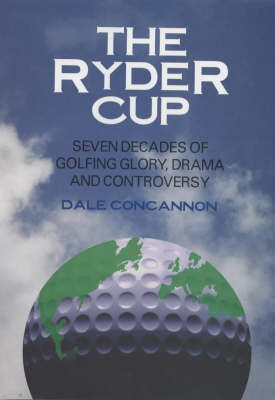
The Ryder Cup
A History
Seiten
2001
Aurum Press (Verlag)
978-1-85410-787-9 (ISBN)
Aurum Press (Verlag)
978-1-85410-787-9 (ISBN)
- Titel ist leider vergriffen;
keine Neuauflage - Artikel merken
Dale Concannon is a full-time golf journalist whose previous books include "From Tee to Green", "The Round of My Life" and "Golf: A Glorious Game". This book provides a history of the Ryder Cup.
The scenes at Brookline Country Club in September 1999, when the American players and caddies charged onto the final green in an atmosphere of triumphalism and premature celebration, so wrecking Olazabal's chances of holding his putt to keep the match and the contest alive, thrust the Ryder Cup into the headlines - and not for the first time. For the entire 74 years of its history this unique competition has regularly raised golfing tempers to boiling point on both sides of the Atlantic. It all started amiably enough when the wealthy seed merchant Samuel Ryder, impressed by the camaraderie between British and American golfers during practice for the 1926 British Open agreed to provide a trophy to be competed for by teams from the two countries, each of which would host the contest once every four years. The sense of shock in British clubhouses was palpable when the US took the first contest in 1927 by the humiliating margin of 9-1/2 - 2-1/2, though pride was partly restored by a British victory in 1929.
In 1933 there was a foretaste of things to come when, with Britain hosting the contest patriotic crowds overran the fairways leaving a sour taste in the mouths of the defeated visitors. But with the American PGA Tour now producing a steady supply of hardened professional competitors, the tide was running against the British and when competition resumed after the war they suffered a steady stream of defeats, only marginally redeemed by victory in 1957, in a competition again marred by overly partisan spectators. After yet another American victory in 1977, with the contest now clearly becoming an unequal one, and with new European players such as Steve Ballesteros making an increasing impact on the golfing scene, it was decided to make the Cup a Europe v. the US affair. The Europeans, under Tony Jacklin, enjoyed their first victory at the Belfry in 1985 and followed up with two more wins in 1987 (the first time the Americans had lost at home) and 1989.
Then in 1991, in what the Americans seemed to see as a sort of postscript to their Gulf War victory, the US won the intensely fought 'War on the Shore' at Kiawah Island and won again at the Belfry in 1993; after which the Europeans struck back in 1995 and 1997. And then came Brookline...
The scenes at Brookline Country Club in September 1999, when the American players and caddies charged onto the final green in an atmosphere of triumphalism and premature celebration, so wrecking Olazabal's chances of holding his putt to keep the match and the contest alive, thrust the Ryder Cup into the headlines - and not for the first time. For the entire 74 years of its history this unique competition has regularly raised golfing tempers to boiling point on both sides of the Atlantic. It all started amiably enough when the wealthy seed merchant Samuel Ryder, impressed by the camaraderie between British and American golfers during practice for the 1926 British Open agreed to provide a trophy to be competed for by teams from the two countries, each of which would host the contest once every four years. The sense of shock in British clubhouses was palpable when the US took the first contest in 1927 by the humiliating margin of 9-1/2 - 2-1/2, though pride was partly restored by a British victory in 1929.
In 1933 there was a foretaste of things to come when, with Britain hosting the contest patriotic crowds overran the fairways leaving a sour taste in the mouths of the defeated visitors. But with the American PGA Tour now producing a steady supply of hardened professional competitors, the tide was running against the British and when competition resumed after the war they suffered a steady stream of defeats, only marginally redeemed by victory in 1957, in a competition again marred by overly partisan spectators. After yet another American victory in 1977, with the contest now clearly becoming an unequal one, and with new European players such as Steve Ballesteros making an increasing impact on the golfing scene, it was decided to make the Cup a Europe v. the US affair. The Europeans, under Tony Jacklin, enjoyed their first victory at the Belfry in 1985 and followed up with two more wins in 1987 (the first time the Americans had lost at home) and 1989.
Then in 1991, in what the Americans seemed to see as a sort of postscript to their Gulf War victory, the US won the intensely fought 'War on the Shore' at Kiawah Island and won again at the Belfry in 1993; after which the Europeans struck back in 1995 and 1997. And then came Brookline...
Dale Concannon is a full-time golf journalist whose previous books include From Tee to Green (1997), The Round of My Life (1998) and Golf: A Glorious Game (1999).
| Zusatzinfo | b&w illustrations |
|---|---|
| Sprache | englisch |
| Maße | 156 x 234 mm |
| Gewicht | 528 g |
| Themenwelt | Sachbuch/Ratgeber ► Sport ► Golf |
| Geisteswissenschaften ► Geschichte | |
| ISBN-10 | 1-85410-787-9 / 1854107879 |
| ISBN-13 | 978-1-85410-787-9 / 9781854107879 |
| Zustand | Neuware |
| Informationen gemäß Produktsicherheitsverordnung (GPSR) | |
| Haben Sie eine Frage zum Produkt? |
Mehr entdecken
aus dem Bereich
aus dem Bereich
Das Versprechen
Buch | Softcover (2023)
Fischer Taschenbuch (Verlag)
CHF 19,90
gültig in Deutschland ab April 2024
Buch | Softcover (2024)
Köllen (Verlag)
CHF 27,85


